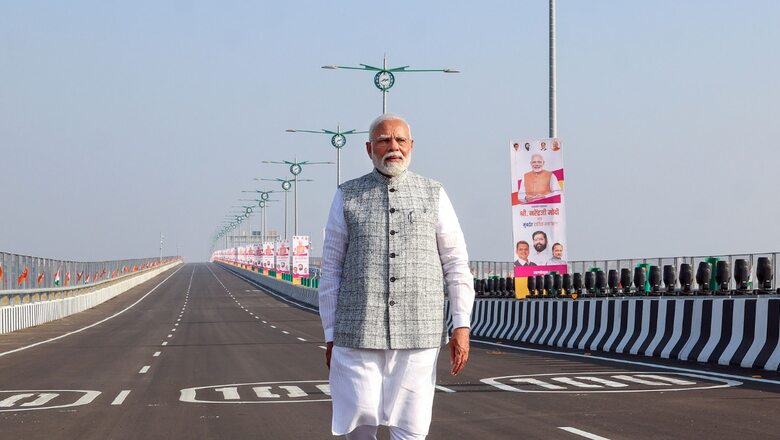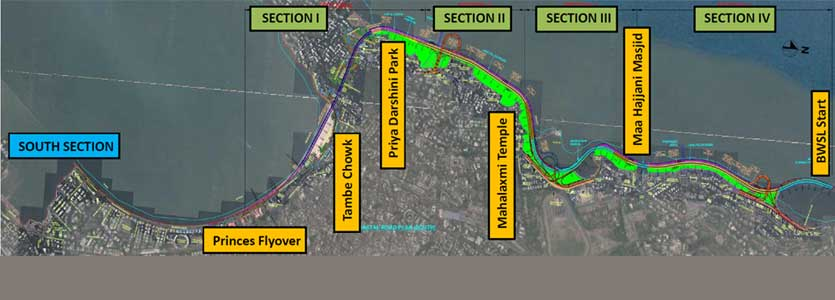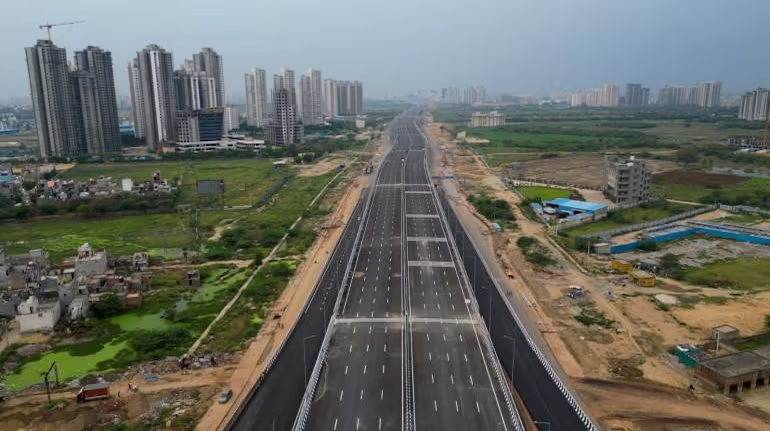
views
India’s ambitious infrastructural agenda, spearheaded by Prime Minister Narendra Modi, is set to usher in a new era of connectivity and economic growth. As the nation approaches the 2024 elections, myriad of transformative projects are on the brink of completion, promising to reshape the landscape of transportation, commerce, and urban development.
Here are the top 15 infrastructural projects poised for inauguration in 2024.
Mumbai Trans Harbour Link: Strategic Connectivity
Inaugurated by Prime Minister Modi on January 12, the Mumbai Trans Harbour Link is a 21.6km engineering marvel connecting Mumbai with mainland Navi Mumbai. Developed by the MMRDA at an estimated cost of Rs 18,000 crore, it promises to revolutionise travel time between the two regions.
Linking Mumbai with Navi Mumbai, the Mumbai Trans Harbour Link is poised to redefine regional connectivity and promote economic development. The six-lane bridge, starting from Sewri in South Mumbai and terminating at Chirle near Nhava Sheva, is expected to create job opportunities, foster real estate development, and ease traffic congestion for smoother transportation of goods and services.
Agra Metro: Enhancing Connectivity to the Taj Mahal
The inauguration of a 6km Metro stretch in Agra, connecting key points, including the Taj Mahal, signifies a crucial step in alleviating congestion and enhancing passenger convenience. Developed by the Uttar Pradesh Metro Rail Corporation (UPMRC), the project encompasses two corridors: Sikandara to Taj East Gate and Agra Cantt to Kalindi Vihar. Upon completion, this Metro network will seamlessly connect key points across the city, including railway stations, bus stops, and significant tourist attractions.
The Agra Metro is poised to enhance cultural and heritage tourism. It provides convenient access to the Taj Mahal, Agra Fort, and other historical landmarks, boosting tourism. The Agra Metro is designed as a model for sustainable and eco-friendly urban transportation, integrating local communities in project planning and execution to ensure socio-economic benefits.
Mumbai Coastal Road
The Mumbai Coastal Road is a transformative infrastructure project designed to enhance connectivity along the city’s picturesque waterfront. Stretching approximately 29.2km, this ambitious road aims to reduce travel time, alleviate traffic congestion, and provide a scenic and efficient route along the Arabian Sea.

The Mumbai Coastal Road is expected to significantly ease traffic congestion by offering an alternative route that runs parallel to the existing road networks. With strategically planned interchanges and a dedicated coastal route, the project aims to reduce travel time for commuters, making transportation more efficient and streamlined. Besides its functional benefits, the road promises a picturesque drive along the Arabian Sea, contributing to the overall connectivity of the city.
The road is designed to connect key areas of Mumbai, providing improved accessibility to various neighborhoods. It incorporates green spaces, promenades, and scenic viewpoints, adding a recreational dimension to the urban infrastructure. The Mumbai Coastal Road is also designed with smart and sustainable features, emphasizing eco-friendly design principles and incorporating intelligent traffic management systems for overall efficiency and safety.
Aqua Line 3 of Mumbai Metro: Underground Connectivity
The 33.5-KM Aqua Line 3 of Mumbai’s Metro Network is set to provide underground connectivity along the Colaba-Bandra-SEEPZ corridor. Expected to be operational in 2024, it is estimated to cost around Rs 33,000 crore and serve more than 16 lakh commuters daily.
Developed as a joint venture between the Government of India and the Government of Maharashtra, Aqua Line 3 incorporates state-of-the-art signaling systems for safe and efficient Metro operations. The project aims to alleviate traffic congestion by offering a reliable and fast alternative for daily commuters, contributing to the city’s overall urban development.
Chenab Bridge
The Chenab Bridge in Jammu and Kashmir is set to become the world’s highest rail bridge, spanning 13,115 meters and towering at 359 meters. As a crucial link in the Udhampur-Srinagar-Baramulla rail project, its completion in 2022 marks a milestone in enhancing connectivity in the region.
Engineered to withstand winds up to 260 kmph and designed for a lifespan of 120 years, the Chenab Bridge has passed mandatory tests including high-velocity winds, extreme temperatures, earthquakes, and hydrological impacts. Sustainability measures are implemented, aligning with global standards and incorporating eco-friendly construction practices.
Dwarka Expressway
The Dwarka Expressway, jointly executed by J Kumar Infraprojects and Larsen & Toubro, is set to be inaugurated as India’s inaugural fully access-controlled 8-lane elevated route. Spanning 29.10 km from Mahipalpur (Shiv Murti) in Delhi to Kherki Dhaula via New Gurgaon (Gurugram) in Haryana, this project addresses traffic congestion and facilitates seamless connectivity.

Integrated with Delhi’s Master Plan 2021, the Dwarka Expressway is strategically designed to connect major growth corridors, enhancing accessibility and reducing commute times. The project, with over 20 flyovers/bridges, 11 vehicle underpasses, and numerous pedestrian facilities, aligns with sustainable urban development goals and accommodates future urban expansion.
Delhi-Mumbai Expressway: Driving Economic Growth
The Delhi-Mumbai Expressway, spanning 1,350 km, is a strategic project aimed at reducing travel time between two major economic centers. Inaugurated in segments, this controlled-access highway facilitates efficient movement of goods and incorporates designated greenfield sites for integrated logistics and warehousing hubs.
Divided into four sections with 52 construction packages, the Delhi-Mumbai Expressway aims to boost trade activities, supporting businesses with faster and more cost-effective transportation. The project, initiated in March 2019, is expected to spur economic development along its route and decrease travel duration between Delhi and Mumbai from 24 to 12 hours.
Navi Mumbai International Airport: Aviation Hub
The greenfield Navi Mumbai International Airport, managed by Adani Airports Holdings Ltd, is expected to address capacity enhancement in the Mumbai Metropolitan Region. With a Phase 1 capacity of 20 million passengers per annum, it is set to be completed by the end of 2024.
Navi Mumbai International Airport, in its first phase, aims to cater to 20 million passengers per annum, addressing the growing demand for air travel. It enhances Mumbai’s status as a major aviation hub, fostering economic activities in the region. Subsequent phases are planned to increase the total capacity to 60 million passengers per annum, strategically located to complement existing transportation networks.
Noida International Airport: Global Collaboration
Operated by Yamuna International Airport Pvt Ltd, a subsidiary of Zurich Airport International AG, Noida International Airport is scheduled to be operational by the Oct-Dec quarter in 2024. With a capacity reaching 70 million passengers, it aims to become the largest airport in Asia.
Noida International Airport, operated by Zurich Airport International AG, is set to bring Swiss efficiency to Indian aviation. The project, developed in phases, accommodates 12 million passengers in Phase 1 and has the potential to reach 70 million by the end of Phase 4. Collaboration with Swiss experts ensures the implementation of global best practices in airport management and passenger experience.
Western Dedicated Freight Corridor
The Western Dedicated Freight Corridor (WDFC), developed by the Indian Railways, is a transformative railway infrastructure project spanning Uttar Pradesh, Haryana, Rajasthan, Gujarat, and Maharashtra. It aims to establish a seamless link from Dadri in Uttar Pradesh to the Jawaharlal Nehru Port Trust (JNPT) in Maharashtra.
A dedicated corridor for freight transportation, the WDFC enhances logistics, promotes economic activities, and reduces transit time for cargo. With 938 km operational and remaining alignment targeted for completion, the corridor serves as a dedicated pathway for freight trains, contributing to economic growth and industrial corridor development.
Passing through key industrial and economic hubs, including Ahmedabad, Vadodara, and Surat, the WDFC has the potential to spur industrial development, create new economic corridors, and connect the northern hinterland to western ports, notably JNPT in Maharashtra. The corridor’s segregation of freight traffic from passenger trains aims to enhance operational efficiency, reduce delays, and contribute to environmental sustainability.
Char Dham All-Weather Road
Chardham Mahamarg Vikas Pariyojna is a project of the central government to improve the existing condition of highways in Uttarakhand. The project involves upgrading and developing the road that connects all four ‘Dhams’ i.e Gangotri, Yamunotri, Kedarnath, and Badrinath. The 12,000-crore dream project will turn 1100 km damaged highways of Uttarakhand into all seasons road, boosting the economy and industries related to travel in the state.
This strategic road network improves accessibility to sacred sites, boosting tourism and regional development. The project, divided into 7 packages and costing INR 12,000 Crore, benefits the economy, decreases road accidents, and enhances overall travel efficiency. It creates new jobs, decreases migration, and aids the security of Indian borders along with China.
Sela Tunnel
The Sela Tunnel, a monumental infrastructural endeavor, is an all-weather road tunnel strategically located in the rugged terrains of Arunachal Pradesh. Spanning approximately 13.5km, this engineering marvel aims to connect the Tawang region with the rest of Arunachal Pradesh and the country at large.
The Sela Tunnel ensures year-round connectivity, overcoming the challenges posed by heavy snowfall and harsh weather conditions. Beyond its civilian utility, the tunnel holds significant importance in terms of national security, enhancing the mobility of defense forces in strategically sensitive border areas. Economically, the tunnel stimulates economic activities by facilitating the smooth movement of goods and people, encouraging tourism, trade, and commerce in Arunachal Pradesh.
Additionally, the tunnel promotes cultural integration by connecting the Tawang region, known for its rich cultural and religious heritage, with the rest of the country and serves as a vital link between India and Bhutan, strengthening diplomatic ties and facilitating bilateral trade.
Samruddhi Mahamarg: Transforming Connectivity from Nagpur to Mumbai
The Samruddhi Mahamarg project, officially named ‘Hindu Hrudaysamrat Balasaheb Thackeray Maharashtra Samruddhi Mahamarg,’ is a monumental 701-km expressway connecting Nagpur to Mumbai via Thane district. Inaugurated in two phases, the first phase covered a substantial 520-km stretch from Nagpur to the revered temple town of Shirdi in Ahmednagar district, inaugurated by Prime Minister Narendra Modi in December 2022. This phase laid the foundation for improved travel infrastructure and connectivity in the region.
The second phase extended the operational length to 600 km, with an additional 80-km stretch between Shirdi and Bharvir village in Igatpuri taluka in Nashik district inaugurated on 27 May 2023, by Chief Minister Eknath Shinde and Deputy Chief Minister Devendra Fadnavis. The Maharashtra State Road Development Corporation (MSRDC) oversees the project, with Phase-III, covering the remaining 101 km from Igatpuri to Vadpe in Thane, under construction.
About 80 km of this phase has been completed, and it is anticipated to be fully operational by July 2024, connecting Igatpuri to Mumbai seamlessly. The Samruddhi Mahamarg project stands as a testament to Maharashtra’s commitment to infrastructure development, promising to redefine regional connectivity and stimulate economic growth along its route.
Ramayapatnam, Bhavanapadu, Kakinada Gateway port and Machilipatnam: Catalyst for Maritime Growth
Andhra Pradesh is actively developing four new ports along its 974 km coastline, investing approximately Rs. 120 billion, as confirmed by the Andhra Pradesh Maritime Board (APMB). The board anticipates the completion of all four ports – Bhavanpadu, Kakinada Gateway, Machilipatnam, and Ramayapatnam – by the end of 2024, providing a significant impetus to the state’s economic growth.
Deputy Chief Executive Officer of the Andhra Pradesh Maritime Board, Ravindranath Reddy, states that the operationalization of Ramayapatnam, Bhavanapadu, Kakinada Gateway Port, and Machilipatnam is expected by the close of 2024. This initiative underscores the state’s commitment to expeditious infrastructure development, with the nearly finished first phase of Ramayapatnam Port exemplifying the proactive approach.
Ramayapatnam and Machlipatnam Ports are poised to become key players in regional and national maritime trade, aligning with the state’s vision for rapid infrastructure development and economic expansion. Upon completion, Andhra Pradesh will boast a total of seven operational ports.
Jiribam-Imphal Railway Project and the Noney Bridge: Connecting Northeast India with Excellence
Marking a significant milestone for Northeast India, the Jiribam – Imphal new line railway project nears completion, with Indian Railways actively contributing to the region’s transformation. The Noney Bridge, an engineering marvel, is on track to become the world’s tallest Railway pier bridge at 141 meters, currently 80 percent complete. Demonstrating human ingenuity and engineering excellence, it overcomes geographical challenges for seamless rail connectivity.
The completed Noney Bridge and Jiribam – Imphal Railway line are poised not only to enhance connectivity but also to drive economic development in Manipur and surrounding regions. The efficient rail transportation is expected to cut costs, boost trade, attract investments, create jobs, and contribute to regional prosperity.
This project plays a crucial role in integrating the North-eastern states with the rest of the country through improved connectivity, stimulating trade, tourism, and people-to-people interactions. The Jiribam – Imphal railway project involves multiple tunnels (61.32 km in total) and the construction of 11 major bridges and 137 minor bridges.


















Comments
0 comment